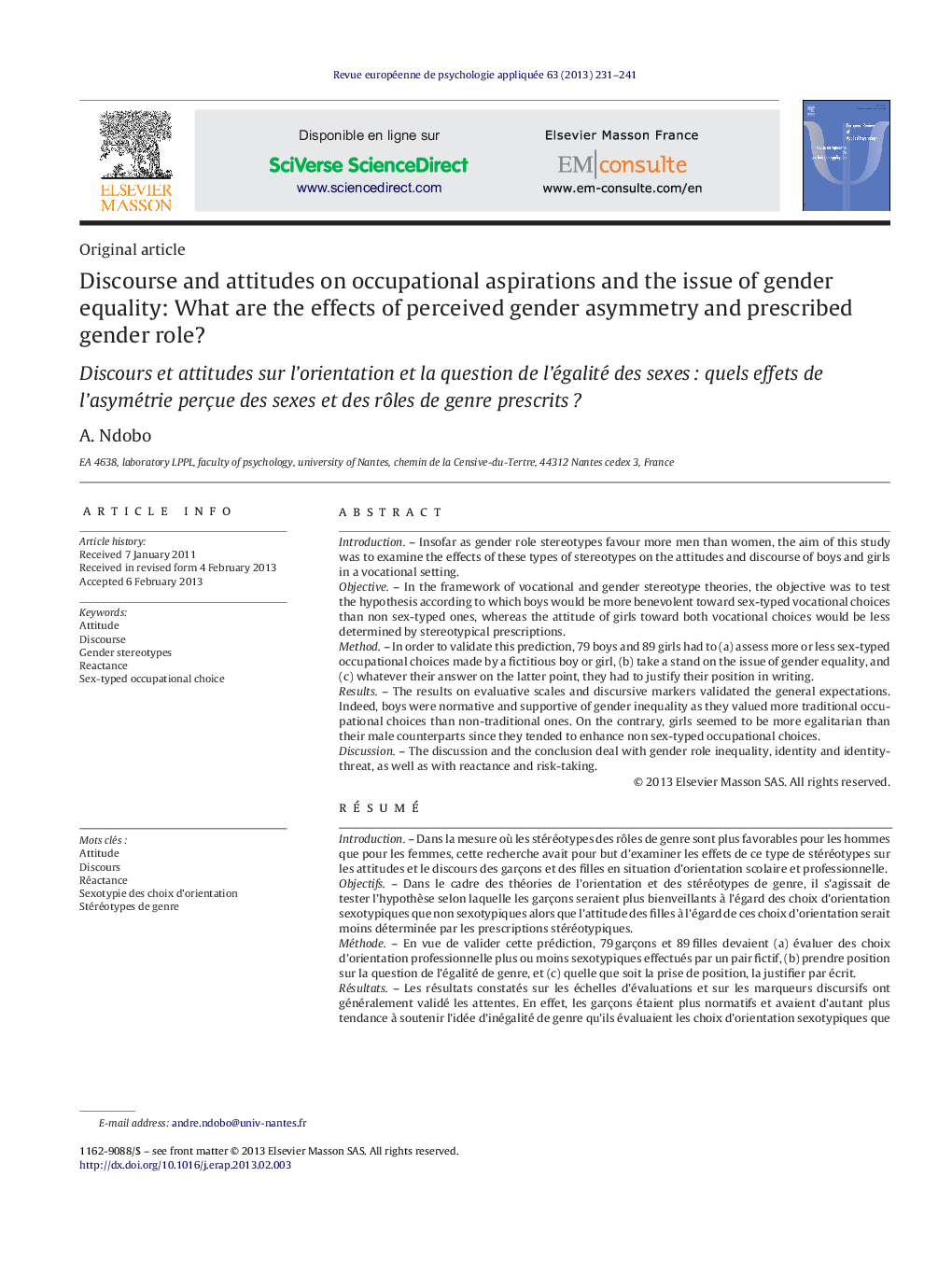| کد مقاله | کد نشریه | سال انتشار | مقاله انگلیسی | نسخه تمام متن |
|---|---|---|---|---|
| 895511 | 914659 | 2013 | 11 صفحه PDF | دانلود رایگان |

IntroductionInsofar as gender role stereotypes favour more men than women, the aim of this study was to examine the effects of these types of stereotypes on the attitudes and discourse of boys and girls in a vocational setting.ObjectiveIn the framework of vocational and gender stereotype theories, the objective was to test the hypothesis according to which boys would be more benevolent toward sex-typed vocational choices than non sex-typed ones, whereas the attitude of girls toward both vocational choices would be less determined by stereotypical prescriptions.MethodIn order to validate this prediction, 79 boys and 89 girls had to (a) assess more or less sex-typed occupational choices made by a fictitious boy or girl, (b) take a stand on the issue of gender equality, and (c) whatever their answer on the latter point, they had to justify their position in writing.ResultsThe results on evaluative scales and discursive markers validated the general expectations. Indeed, boys were normative and supportive of gender inequality as they valued more traditional occupational choices than non-traditional ones. On the contrary, girls seemed to be more egalitarian than their male counterparts since they tended to enhance non sex-typed occupational choices.DiscussionThe discussion and the conclusion deal with gender role inequality, identity and identity-threat, as well as with reactance and risk-taking.
RésuméIntroductionDans la mesure où les stéréotypes des rôles de genre sont plus favorables pour les hommes que pour les femmes, cette recherche avait pour but d’examiner les effets de ce type de stéréotypes sur les attitudes et le discours des garçons et des filles en situation d’orientation scolaire et professionnelle.ObjectifsDans le cadre des théories de l’orientation et des stéréotypes de genre, il s’agissait de tester l’hypothèse selon laquelle les garçons seraient plus bienveillants à l’égard des choix d’orientation sexotypiques que non sexotypiques alors que l’attitude des filles à l’égard de ces choix d’orientation serait moins déterminée par les prescriptions stéréotypiques.MéthodeEn vue de valider cette prédiction, 79 garçons et 89 filles devaient (a) évaluer des choix d’orientation professionnelle plus ou moins sexotypiques effectués par un pair fictif, (b) prendre position sur la question de l’égalité de genre, et (c) quelle que soit la prise de position, la justifier par écrit.RésultatsLes résultats constatés sur les échelles d’évaluations et sur les marqueurs discursifs ont généralement validé les attentes. En effet, les garçons étaient plus normatifs et avaient d’autant plus tendance à soutenir l’idée d’inégalité de genre qu’ils évaluaient les choix d’orientation sexotypiques que non sexotypiques. Au contraire, les filles semblaient plus égalitaristes que les garçons et avaient plus tendance à valoriser les choix d’orientation professionnelle non sexotypiques.DiscussionLa discussion porte sur les questions d’inégalité des rôles de genre, d’identité et de menace identitaire, de réactance et de prise de risque.
Journal: Revue Européenne de Psychologie Appliquée/European Review of Applied Psychology - Volume 63, Issue 4, July 2013, Pages 231–241